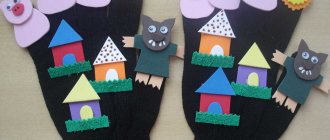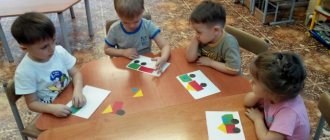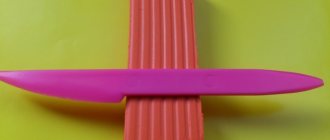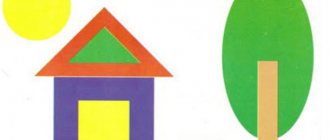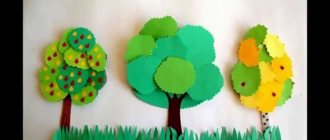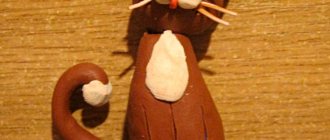Small children experience the world by touch. Application helps to embody the images and objects seen on paper or using other materials. For small children, paper dishes using the appliqué technique will be a good opportunity to learn the names of objects. And adult children hone their skills of believability in crafts.
It can be made from paper, fabric and plasticine. Tableware applique is most often simple and almost all of its types are suitable for preschoolers and kindergarteners. And having supplemented the basic craft with his own elements, the child will take the craft to school.
Glasses in applique
Offer to make your child a refreshing glass of lemonade. Cut out the glass. The lemon circles will be made from circles and triangles of colored paper. Ice cubes are made from soaked thin napkins. Add a straw and the craft is ready.
You can make a summer cocktail using a colored paper coffee cup. Cut it in half lengthwise and stick it on cardboard. Garnish with a citrus slice (umbrella). Decorate the background as desired.
Complex panel of coffee beans
And a panel of coffee beans in the shape of a cup will definitely amaze everyone. This is a complex craft, so children will need adult help. Prepare:
- Thick cardboard 2 mm (pressed)
- Superglue, PVA
- Plastic bottle 1.5 l
- Masking tape and regular tape
- Ground coffee
- Coffee beans
Cut this shape out of the bottle.
Cut off the neck and get half a cup.
Glue it to the plastic “bottom” and cover it with masking tape.
Apply PVA glue and sprinkle with ground coffee.
Cut out a saucer from thick cardboard and bend it slightly.
We also cover it with glue and sprinkle it with ground coffee.
Then we glue the grains onto superglue or hot glue.
Let's start assembling the panel. Again, take thick cardboard or a thin sheet of drywall. Come up with a frame. Cover the background with crumpled paper (suitable for baking). Decorate the edges with broken cinnamon sticks, siding or coffee beans. Glue the cup and saucer. Glue a handle from the grains.
They are also made from natural materials. You can make a panel of tea leaves using a herbarium of currants, cherries, and dried berries.
Paper applications are not always suitable for children's games. They are not durable and get dirty quickly. But they will become a worthy interior decoration or a craft for school. With the help of dishes, kids learn the names of dishes and their purpose. A master class with coffee beans is suitable for children in grades 4-5.
In the decoupage technique in the middle group “Introduction to the decoupage technique.” Painted dishes."
1. Introduce children to an unconventional artistic technique - decoupage. With the help of a teacher, decorate interior items using the decoupage technique.
2. Develop design skills: place objects in accordance with the characteristics of their shape; develop creative abilities.
3. Foster love and respect for antique household items.
4. Foster friendliness and maintain interest in joint creativity.
Preliminary work.
1. View a presentation about the technique “Decoupage.
2. Reviewing magazines containing designer works (furniture, accessories, dishes).
Materials and equipment: wooden spoons, forks, boards, napkins for decoupage, PVA glue, large brushes, water-based varnish, scissors.
Progress of the lesson:
Guys, today we will go to the exhibition. But this exhibition is unusual. Craftswomen from all over Russia came to see it. Previously in Rus', craftswomen were called ! Why do you think they were called that?
Children's assumptions and answers.
Right! Because they did it with their hands! We sewed, crafted, decorated! And simple objects turned into extraordinary beauty!
Slide show.
But this was a long time ago in Rus'. And now the craftsmen who decorate and transform simple things into extraordinary ones are called designers. A designer can use simple objects, for example, take a glass jar and a decorative napkin and create with his own hands a very beautiful vase that everyone will admire.
Slide show.
Do you want to look at the needlewomen and the goods that they decorated themselves and brought to the exhibition?
But we guys won’t go to the exhibition. Let's ride the horse like before. After all, a long time ago, all of them were masters: and these are our ancestors: our grandparents rode horses.
Game exercise “Horses”.
Children come to the hall where there is a small exhibition of dishes. A girl in a Russian dress sits nearby and cries.
Q: Guys, who is this crying? Let's go and have a look.
Q: Beautiful girl, why are you crying? What's happened? And who are you?
D: I am Marya, a needlewoman! And I’m crying because my mother and father sent me to an exhibition, they collected painted dishes so that I would surprise people with the beauty of painted dishes! Father made the dishes with his own hands, and my mother and I painted them. But I just lost my bundle, and all the dishes were in it. What should I do now? How to return home?
Q: Don’t cry, Marya is a needlewoman. I think the guys and I can help you! Guys, how can we help Marya?
Children's answers.
How are we going to paint the dishes?
Children's answers.
Would you like us to make you not just painted dishes, but dishes made using the decoupage technique? This is a work technique when you glue beautiful patterns, pictures, ornaments onto a wooden product, and then cover them with varnish. And such a product looks almost like it was painted by master artists. Well, shall we get started?
The teacher shows and explains the procedure: first cut out the required patterns from napkins, layer them (you must leave the last, third layer, then put a sufficient amount of glue on the brush and, pressing from the middle, glue the pattern. Possible patterns are shown. Children listen to Russian folk songs.
Educator: now our work must dry. While the glue dries, we will play a Russian folk game.
Educator: guys, let's finish our work. In order for our dishes to shine and not be scratched, we will cover them with a special varnish.
Children use water-based varnish to coat the items.
Marya the needlewoman:
Thank you guys! What beautiful dishes you made for me, I can’t take my eyes off them! Mother and father will be happy. They had never seen such beauty before. I just forgot what the name of the technique you used to make the dishes is called?
Children's answers.
Marya – needlewoman: Oh, yes, “decoupage”! Now I will remember this word and tell my family and show them how they can decorate objects using a simple napkin. I'll hurry right now! Goodbye!
The children say goodbye.
Educator: Guys, you are great. We helped Marya, a needlewoman. Everyone tried their best, and everyone did it very beautifully! You are real designers! Now it's time for us to return home. Where is our horse?
On frosty long winter evenings it’s so great to sit in good friendly company with a cup of warm aromatic tea.
We invite you to organize such a warm evening of creativity in the company of your child. The news portal “site” in this article has prepared for you two not difficult, but very interesting master classes on how to make cup and saucer appliques with your own hands.
Cups and teapots
Using the cutout appliqué technique, create dishes for children's tea parties. If the product is made of white sheet, then it is decorated with paints or felt-tip pens, and scrapbooking paper will immediately make a beautiful cup.
Cut out the stencil and fold it in half. The dotted lines are the fold locations. Glue it together and the cup is ready.
They also make tea sets.
The composition of buttons looks no less interesting. It is important to choose a color scheme so that the work is not too colorful.
For the next creation you need an openwork napkin (it can be cut out), colored paper, cardboard, paints, scissors and glue.
We glue an openwork napkin onto the cardboard. A cup is cut out on top. Decorate randomly. Draw or cut out white steam. We complement the tea party with candy. You can create a cup from the cover of a magazine or newspaper, or special gift packaging.
For your attention – a teapot made of fabric.
Simply cut out the thin fabric and glue it onto the cardboard. The centers of flowers can be buttons or beads.
Applique tableware - master class
Let's make an application on the theme “Dishes”.
Here, of course, a variety of approaches and goals are possible. I plan to work not with kids, but with grades 1-2. The people are already adults, the tasks will be difficult.
Let's start with painting one teapot - here is the coloring:
The task is to come up with a beautiful pattern. And something typical for dishes - flowers, berries or a geometric pattern. This explanation is definitely necessary, since students, having received the task of painting dishes, begin to look for inspiration in the environment - and this, as you understand, is tables on the walls and textbooks on desks. This is modern life. So try to keep your children from painting letters, numbers and graphs.
But now - the teapot is painted and you need to cut it along the contour. Here we repeat the methods of cutting a hole in paper and train our intelligence - the spout, although it is separated in the picture by a line from the body of the kettle, cannot be cut off, but what about the lid? The lid is removable! But there is no need to cut it off either.
The next task is a cup. It needs to be painted in the same style as the teapot. This is one service.
The goal is to copy the drawing with a change in scale. You can make a border around the edge of the saucer. Drawing tea in a cup is also not an easy task.
Cutting out a cup is also a tricky business - there is a hole in the handle and a saucer - some thoughtlessly cut off this saucer. But we act consciously and measure and think seven times before cutting.
I invite students to draw the sugar bowl themselves. The shape is approximately like that of a teapot, only without a handle and spout. But don't think it's easy - it's symmetrical! So you will have to work hard, measuring equal distances to the sides of the sugar bowl on both sides of the axis. But here it is ready and painted in the same style as the rest of the dishes.
Now it’s time to draw up a still life - we’ve reached the Utensils appliqué stated in the title of the article.
We mark the edge of the table and arrange the dishes. Here, again, it is necessary to immediately clarify that the dishes do NOT stand on the edge, but are freely distributed - closer and further from the viewer - across the area of the tabletop.
My composition turned out to be beautiful, but... but here’s the problem - the cup’s handle is turned towards the teapot. It's not a big deal, but it's illogical.
Here - the applique of the dishes can be said to be completed. But the picture looks a little sad. Okay, let’s start developing the imagination: add more dishes and food to the table according to your understanding.
I drew, cut and glued a spoon, a bowl of fruit and another cup of tea. The table immediately became richer. A! The tablecloth needs to be laid. The goal is to evenly distribute the pattern across the surface of the table.
Probably, it would be possible to extract even more benefits from the topic “Applique Crockery” for the development of children’s hands and eyes, but - the bell is already ringing! And the students were tired - after all, they worked so hard setting the table.
Tags: paper applique for children, applique with finishing touches, crafts, dishes
